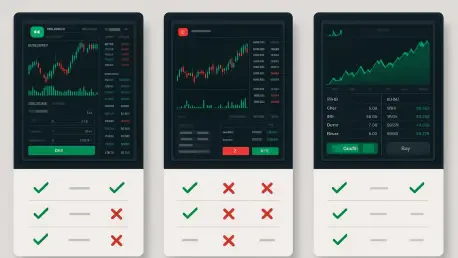In today’s fast-paced financial landscape, where split-second decisions can make or break a trade, selecting the right platform is a critical step for any investor aiming to stay competitive and thrive in the market. The explosion of digital tools has transformed how trading is conducted, offering a range of options from robust desktop setups to agile mobile apps. Each platform type brings distinct advantages and challenges, tailored to different trading styles, levels of experience, and lifestyle demands. Whether a seasoned professional executing complex strategies or a part-time trader checking markets on the go, the choice of platform can significantly impact efficiency and success. This exploration delves into the nuances of desktop, web, and mobile trading systems, shedding light on their unique strengths and limitations. By understanding these differences, traders can make informed decisions that align with their specific goals and circumstances, ensuring they are equipped to navigate the dynamic world of financial markets.
Exploring Platform Options for Diverse Trading Needs
Unpacking the Power of Desktop Platforms
Desktop trading platforms stand as the cornerstone for many professional traders who prioritize depth and precision in their market activities. These systems are often equipped with advanced analytical tools, extensive customization options, and the ability to handle large datasets seamlessly. For those spending long hours at a desk, desktops offer unparalleled support for multi-monitor setups, enabling simultaneous tracking of various markets and indicators. This makes them particularly suitable for complex strategies that demand detailed research and real-time data processing. However, the robust nature of these platforms can feel excessive for beginners or casual traders who may not require such intensive features, highlighting the importance of aligning platform choice with actual trading needs.
Beyond their analytical prowess, desktop platforms provide a stable and secure environment, often preferred by traders dealing with high-stakes transactions. The dedicated hardware ensures minimal latency, a crucial factor during volatile market conditions where speed is of the essence. Additionally, the ability to integrate third-party software and plugins enhances their functionality, catering to niche trading requirements. Yet, this comes at the cost of mobility, as these systems are tied to a specific location, limiting access for those who need flexibility in their trading routines. This trade-off underscores the necessity of evaluating personal schedules and commitments when considering a desktop setup as the primary trading tool.
Assessing the Flexibility of Web-Based Systems
Web-based trading platforms have emerged as a versatile solution, striking a balance between functionality and accessibility for a wide range of traders. Operating directly through a browser, these systems eliminate the need for software installation, allowing access from any device with an internet connection. This feature proves invaluable for individuals who frequently travel or face workplace restrictions on software downloads. Modern advancements have significantly enhanced the capabilities of web platforms, with many now offering sophisticated charting tools and real-time data that rival traditional desktop systems, making them a viable option for intermediate traders.
Despite these improvements, web platforms may still fall short for heavy users who require lightning-fast execution and extensive customization. Connection stability and browser compatibility can occasionally pose challenges, potentially disrupting trading activities during critical moments. Nevertheless, their strength lies in providing a seamless transition across devices, ensuring traders can stay connected to markets without being tethered to a single workstation. For those balancing trading with other professional or personal responsibilities, this adaptability offers a practical middle ground that accommodates a dynamic lifestyle while maintaining essential market access.
Embracing the Convenience of Mobile Trading Apps
Mobile trading platforms cater to the growing need for constant connectivity, enabling traders to engage with markets anytime, anywhere. With smartphones becoming central to daily life, these apps provide the ultimate convenience, allowing users to monitor positions, execute trades, and receive instant alerts on the move. This immediacy is particularly beneficial for part-time traders or busy professionals who cannot remain stationed at a desk. The intuitive interfaces and push notifications ensure that critical market movements are never missed, empowering users to respond swiftly to opportunities or risks as they arise.
However, the compact nature of mobile devices introduces limitations that traders must consider. Smaller screens can hinder detailed analysis, and the reduced charting capabilities often make it challenging to develop or execute complex strategies effectively. While ideal for quick trades or portfolio oversight, mobile apps are less suited for in-depth research or long-term planning. Traders relying on intricate data visualization may find these constraints frustrating, suggesting that mobile platforms are best utilized as a supplementary tool rather than a primary solution for comprehensive trading activities.
Crafting a Tailored Approach to Platform Selection
Combining Strengths for Optimal Results
Recognizing that no single trading platform holds universal superiority, a hybrid approach often emerges as the most effective strategy for many investors. By leveraging the strengths of desktop, web, and mobile systems, traders can address diverse needs across different scenarios. For instance, desktops can serve as the hub for intensive analysis and strategy development, while web platforms provide the flexibility to check markets from various locations or devices. Mobile apps, in turn, ensure immediacy, allowing quick responses to urgent market updates or news alerts. This integrated setup enables adaptability, catering to both planned trading sessions and spontaneous market engagements.
The practicality of combining platforms lies in its ability to mirror the multifaceted nature of modern trading lifestyles. A trader might dedicate early mornings to deep research on a desktop, switch to a web platform during a commute or at a temporary workspace, and rely on a mobile app for evening updates. This fluidity ensures that no opportunity is missed, regardless of location or time constraints. Embracing such a strategy requires a clear understanding of each platform’s role within the broader trading framework, allowing for a seamless blend of power, accessibility, and convenience that enhances overall market responsiveness.
Aligning Technology with Trading Goals
Reflecting on the insights shared, it becomes evident that the journey to selecting the right trading platform is deeply personal, shaped by individual priorities and market demands. Traders who value detailed analytics often gravitate toward desktop systems, while those needing flexibility find solace in web-based options. Mobile apps, meanwhile, carve a niche for on-the-go engagement, proving indispensable during fast-paced market shifts. The consensus is clear: understanding the unique benefits and drawbacks of each system is paramount to crafting a setup that supports specific trading aspirations.
Looking back, the most actionable takeaway is the encouragement to experiment with a mix of platforms to discover the ideal balance. Traders are advised to assess their time commitment, analytical depth, and mobility needs before settling on a primary tool or combination. By revisiting their strategies and staying open to evolving technologies, they position themselves to adapt to future market dynamics. This thoughtful alignment of technology with personal goals paves the way for sustained efficiency and success in navigating the ever-changing financial landscape.









